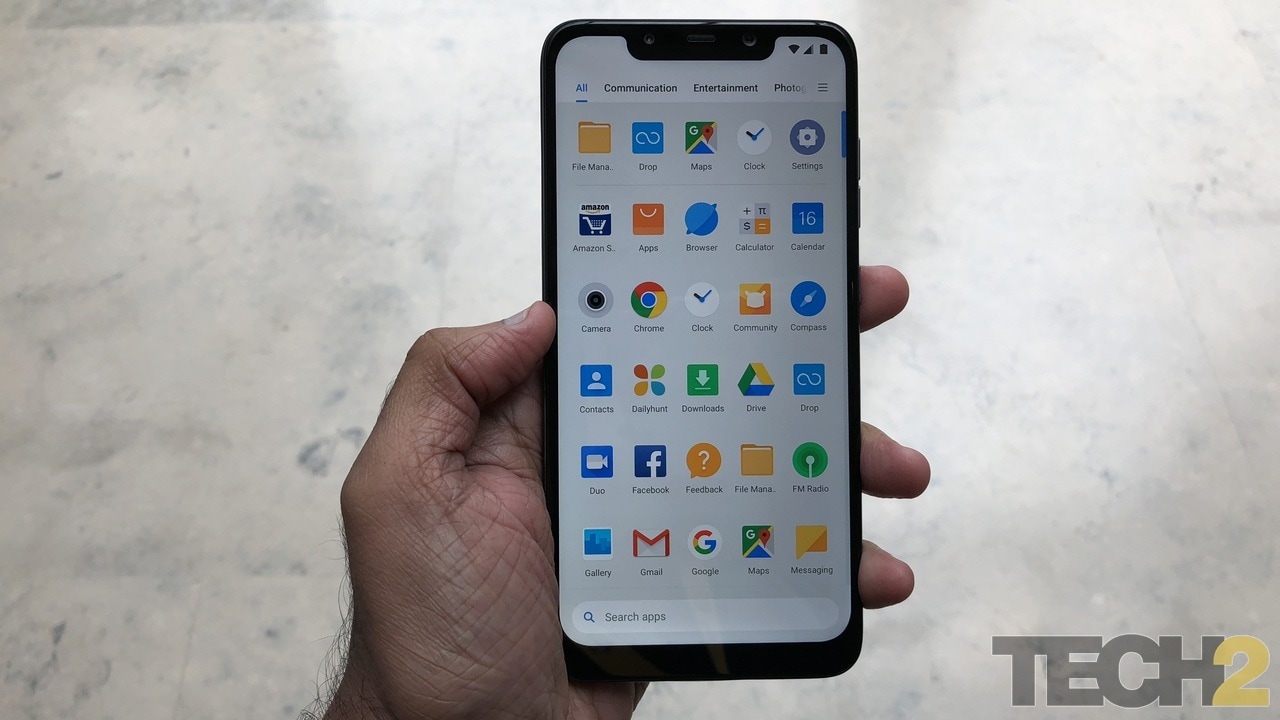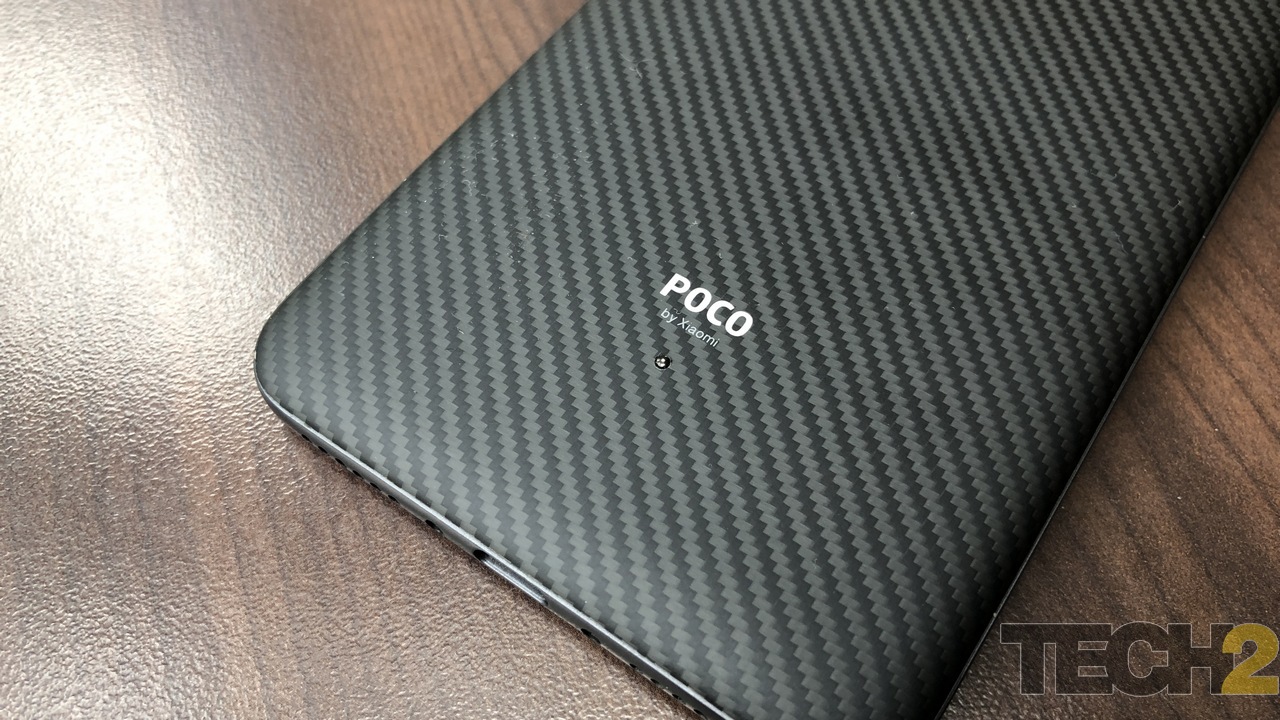Xiaomi’s sub-brand Pocophone just launched its very first smartphone, the
**Poco F1** . Now Pocophone is straightaway targetting the most popular flagship smartphone maker in India which is OnePlus. While the
**OnePlus 6** was being sold under the slogan “The Speed You Need” the Poco F1, is being sold under the slogan “Master of Speed”. However, what Poco F1 has really become is the ‘Master of pricing’. Starting at Rs 20,999 (introductory offer at Rs 19,999) the Poco F1 happens to be the cheapest smartphone offering flagship grade hardware. [caption id=“attachment_5020661” align=“alignnone” width=“1024”] Poco F1. Image: tech2/Nimish Sawant[/caption] But is the Poco F1 truly the “Master of speed?” It certainly boasts the right kind of hardware that might make it a worthy challenger in the budget flagship smartphone category, but that’s a category that the F1 looks set to redefine. Normally, its competition would include the OnePlus 6,
**Honor 10** ,
**Asus ZenFone 5Z** and maybe even the LG G7 ThinQ. However, none of these phones come even close to the ridiculously low price tag set by Pocophone. At a starting price of Rs 20,999, the Poco F1 completely turns the market on its head. Where a Rs 20,000 budget would get you something like a Vivo X21 or Oppo F9, the Poco F1 offers flagship performance and features. To put it another way, the Poco F1 is the cheapest phone with the Snapdragon 845 chipset. There is no phone on Earth that offers Qualcomm’s latest flagship processor at that price. The starting model of the device comes with 6 GB RAM and 64 GB internal storage and there are also higher storage variants available for the smartphone. There is also the option to extend the storage by 256 GB using a microSD card, something which neither the OnePlus 6 has nor the Honor 10 offer. [caption id=“attachment_5020671” align=“alignnone” width=“1280”]
Poco F1. Image: tech2/Nimish Sawant[/caption] While both the Asus ZenFone 5Z and the OnePlus 6 have the Snapdragon 845 SoC, the Honor 10 has to contend with a decidedly lower power Kirin 970 chipset. There is also one very unique feature that no one in the sub-Rs 40,000 price range has and that is the “LiquidCool Technology” that was announced. As per Pocophone, this will help in better heat dissipation in the device and is ideal for users who are into mobile gaming. Thumbs up to Poco for that. However, only a full review will let us know how good or bad this LiquidCool tech really is. In terms of the display, the Poco F1 has a 6-inch FHD+ IPS LCD display and, as the design trend of 2018 would have it, a big display notch. The phone also seems to have a sizeable chin**.** Bigger than that on the OnePlus 6 anyway. The OnePlus 6 has an AMOLED display while both the Asus ZenFone 5Z and the Honor 10 sport LCD displays. In our review, we found that the despite the LCD screens, both the Honor 10 and Asus ZenFone 5Z had amazing displays. [caption id=“attachment_5020681” align=“alignnone” width=“1280”]
 Poco F1. Image: tech2/Nimish Sawant[/caption] As far as optics go, the Poco F1 has a dual-camera setup with a 12 MP and a 5 MP sensor while the front-facing camera has a 20 MP sensor. Looking at the OnePlus 6, we see that the phone has 16 MP + 20 MP cameras on the back and a 16 MP camera on the front. In our review, we found out that the Asus ZenFone 5Z actually took better overall photos than the OnePlus 6 while the Honor 10 falls below them both. There’s no clear winner, but in terms of sheer pixel count, the OnePlus 6 is the champion. Below is a table which shows a comparison of all the specifications of the above-mentioned devices. I’ve also thrown in the LG G7 ThinQ just for the heck of it. It’s Rs 39,999 and double the price of the Poco F1, but offers similar specs.
Poco F1. Image: tech2/Nimish Sawant[/caption] As far as optics go, the Poco F1 has a dual-camera setup with a 12 MP and a 5 MP sensor while the front-facing camera has a 20 MP sensor. Looking at the OnePlus 6, we see that the phone has 16 MP + 20 MP cameras on the back and a 16 MP camera on the front. In our review, we found out that the Asus ZenFone 5Z actually took better overall photos than the OnePlus 6 while the Honor 10 falls below them both. There’s no clear winner, but in terms of sheer pixel count, the OnePlus 6 is the champion. Below is a table which shows a comparison of all the specifications of the above-mentioned devices. I’ve also thrown in the LG G7 ThinQ just for the heck of it. It’s Rs 39,999 and double the price of the Poco F1, but offers similar specs.
| Smartphone | Poco F1 | Honor 10 | Asus ZenFone 5Z | OnePlus 6 | LG G7 ThinQ |
|---|---|---|---|---|---|
| Display Size (inch) | 6.1 | 6.1 | 6.2 | 6.3 | 6 |
| Resolution (pixels) | 1080 x 2246 | 1080 x 2240 | 1080 x 2246 | 1080 x 2280 | 1440 x 3120 |
| Pixel Density (PPI) | 403 | 408 | 402 | 402 | 564 |
| Display Type | LCD | LCD | LCD | AMOLED | LCD |
| Dimensions(mm) | 155.5 x 75.2 x 8.8 | 162 x 77 x 8 | 158.1 x 73.8 x 8.5 | 155.7 x 75.4 x 7.8 | 153.2 x 71.9 x 7.9 |
| Weight (gm) | 180 | 153 | 155 | 177 | 162 |
| Dual SIM | Yes | Yes | Yes | Yes | Yes |
| SIM Type | Nano-SIM | Nano-SIM | Nano-SIM | Nano-SIM | Nano-SIM |
| Connectivity Types | GSM / HSPA / LTE/ VoLTE | GSM / HSPA / LTE/ VoLTE | GSM / HSPA / LTE/ VoLTE | GSM / HSPA / LTE/ VoLTE | GSM / CDMA / HSPA / LTE / VoLTE |
| Processor | Qualcomm Snapdragon 845 | HiSilicon Kirin 970 | Qualcomm Snapdragon 845 | Qualcomm Snapdragon 845 | Qualcomm Snapdragon 845 |
| CPU Cores | Octa-core | Octa-core | Octa-core | Octa-core | Octa-core |
| CPU Clock Speed (GHz) | 4x2.8 GHz Kryo 385 Gold & 4x1.8 GHz Kryo 385 Silver | 4x2.4 GHz Cortex-A73 & 4x1.8 GHz Cortex-A53 | 4x2.8 GHz Kryo 385 Gold & 4x1.8 GHz Kryo 385 Silver | 4x2.8 GHz Kryo 385 Gold & 4x1.7 GHz Kryo 385 Silver | 4x2.8 GHz Kryo 385 Gold & 4x1.7 GHz Kryo 385 Silver |
| GPU | Adreno 630, | Mali-G72 MP12 | Adreno 630 | Adreno 630 | Adreno 630 |
| RAM | 6, 8 GB | 4,6 GB | 6,8 GB | 6,8 GB | 6 GB |
| Ruggedness | - | - | - | Splash Proof | IP68 |
| On-Board Memory | 64,128, 256 GB | 64,128 GB | 64, 128, 256 GB | 64,128, 256 GB | 64 GB, 128 GB |
| Expandable Memory | Yes, up to 512 GB | No | Yes, up to 512 GB | No | No |
| Sensors | Face unlock, Fingerprint, Accelerometer, Gyroscope, Proximity, Compass, | Face unlock, Fingerprint, Accelerometer, Gyroscope, Proximity, Compass, | Face unlock, Fingerprint, Accelerometer, Gyroscope, Proximity, Compass, | Face unlock, Fingerprint, Accelerometer, Gyroscope, Proximity, Compass, | Fingerprint, Accelerometer, Gyroscope, Proximity, Compass, Barometer, Active Edge, Magnetometer, |
| Primary Camera | 12MP f/1.9, 5 MP f/2.0 | 16 MP f/1.8 B/W, 24 MP B/W f/1.8, | 12 MP f/1.8, 8 MP f/2.0 | 16 MP f/1.7, 20 MP (16 MP effective) f/1.7 | 16 MP f/1.6, 16 MP f/1.9, |
| Optical Image Stabilisation | No | No | Yes | Yes | Yes |
| Camera Array | Dual Camera | Dual Camera | Dual Camera | Dual Camera | Dual Camera |
| Autofocus System | Phase detection autofocus | Phase detection autofocus | Phase detection autofocus | Phase detection autofocus | Laser + Phase detection autofocus |
| Secondary Camera | 20 MP f/1.7 | 24 MP f/2.0 | 8MP f/1.7 | 16 MP f/2.0 | 8MP f/1.9 |
| Video Capture | 2160p@30fps, 1080p@30fps (gyro-EIS), 1080p@240fps | 2160p@30fps, 1080p@60fps, 1080p@30fps (gyro-EIS) | 2160p@30fps, 1080p@60/120fps 720p @ 240 fps | 2160p@30/60fps, 1080p@30/60/240fps, 720p@480fps | 2160p@30/60fps, 1080p@30/60fps, 720p@240fps |
| Flash | Dual-LED | LED | LED | Dual-LED | Dual-LED |
| OS Version | Android 8.1 Oreo | Android 8.1 Oreo | Android 8.1 Oreo | Android 8.1 Oreo | Android 8.1 Oreo |
| AI (Smart Assistant) | Google Assistant | Google Assistant | Google Assistant | Google Assistant | Yes, Google Assistant |
| GPS | Yes | Yes | Yes | Yes | Yes |
| Wi-Fi | Wi-Fi 802.11 a/b/g/n/ac, dual-band, Wi-Fi Direct, Hotspot | Wi-Fi 802.11 a/b/g/n/ac, dual-band, Wi-Fi Direct, Hotspot | Wi-Fi 802.11 a/b/g/n/ac, Dual-band, Wi-Fi Direct, Hotspot | Wi-Fi 802.11 a/b/g/n/ac, Dual-band, Wi-Fi Direct, Hotspot | Wi-Fi 802.11 a/b/g/n/ac, dual, band, Wi-Fi Direct, DLNA, Hotspot |
| Bluetooth | v5.0, A2DP, LE, aptX | 4.2, A2DP, LE | v5.0, A2DP, LE | v5.0.A2DP,LE, aptX | v5.0, A2DP, LE, aptX HD |
| NFC | TBC | Yes | Yes | Yes | Yes |
| Infrared | No | Yes | No | No | No |
| Fingerprint Scanner | Yes, rear | Yes, rear | Yes, rear | Yes, rear | Yes, rear |
| 3.5 mm jack | Yes | Yes | Yes | Yes | Yes |
| Radio | No | No | Yes | No | No |
| USB Type | Type-C 1.0 reversible connector | Type-C 1.0 reversible connector | Type-C 1.0 reversible connector | Type-C 1.0 reversible connector | Type-C 1.0 reversible connector |
| USB Standard | USB 2.0 | USB 2.0 | USB 2.0 | USB 2.0 | USB 3.0 |
| Battery (mAh) | 4,000 | 3,400 | 3,300 | 3,300 | 3,000 |
| Fast charging | Yes | Yes | Yes | Yes | Yes |
| Colours | Rosso Red, Steel Blue, Graphite Black | Phantom Blue, Phantom Green, Midnight Black, Glacier Grey, Lily White | Midnight Blue, Meteor Silver | Midnight Black, Mirror Black, Silk White, Amber Red | New Platinum Gray, New Aurora Black, New Moroccan Blue, Raspberry Rose |
| Prices in India | Starting at Rs 20,999 | Starting at Rs 32,999 | Starting at Rs 29,999 | Starting at Rs 34,999 | Starting Rs 39,999 |
Conclusion At this stage, even reviewing the device seems like too much bother. The Poco F1 offers so much better hardware on paper that it’s already stolen the value-for-money crown from everything else in the smartphone world. Unless Xiaomi did something horribly wrong with the phone, which, given their track record, hardly seems likely, this phone is simply a class apart. To put things in perspective, Samsung sells the Galaxy J8 with a Snapdragon 450 SoC, an HD display, and 4 GB RAM for 18,999. It doesn’t take a genius to figure out which phone is better. Somewhere in Shenzen, OnePlus is scratching their heads on how to come up with an answer to the Poco F1. Exciting times lay ahead for the smartphone industry. Do stay tuned for our full review, which should be coming soon.


)
)
)
)
)
)
)
)
)



